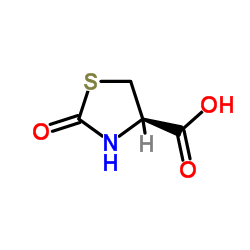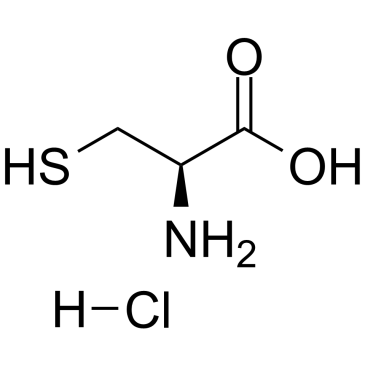Oxothiazolidinecarboxylic acid

Oxothiazolidinecarboxylic acid structure
|
Common Name | Oxothiazolidinecarboxylic acid | ||
|---|---|---|---|---|
| CAS Number | 19771-63-2 | Molecular Weight | 147.152 | |
| Density | 1.6±0.1 g/cm3 | Boiling Point | N/A | |
| Molecular Formula | C4H5NO3S | Melting Point | 174 °C (dec.)(lit.) | |
| MSDS | Chinese USA | Flash Point | N/A | |
| Symbol |

GHS07 |
Signal Word | Warning | |
Use of Oxothiazolidinecarboxylic acidOxothiazolidinecarboxylic acid, an antioxidant, is a prodrug of cysteine that is inert until metabolized to cysteine intracellulary, thus stimulating glutathione synthesis[1]. |
| Name | (4R)-2-oxo-1,3-thiazolidine-4-carboxylic acid |
|---|---|
| Synonym | More Synonyms |
| Description | Oxothiazolidinecarboxylic acid, an antioxidant, is a prodrug of cysteine that is inert until metabolized to cysteine intracellulary, thus stimulating glutathione synthesis[1]. |
|---|---|
| Related Catalog | |
| In Vivo | Oxothiazolidinecarboxylic acid treatment attenuates plantaris atrophy, restored glutathione levels, and increased catalase, Cu/Zn-SOD1, and Mn-SOD2 mRNA expression, but did not reduce other markers of oxidant stress or levels of these catabolic factors[1]. Animal Model: Male Sprague-Dawley rats (200-250 g, n= 6-7 rats/group)[1]. Dosage: 0.35% (w/v). Administration: Added to their diets at a concentration of 0.35% (w/v) for the final 12 wk. Result: Increased fiber CSAs compared to the non-supplemented, alcohol-fed group. |
| References |
| Density | 1.6±0.1 g/cm3 |
|---|---|
| Melting Point | 174 °C (dec.)(lit.) |
| Molecular Formula | C4H5NO3S |
| Molecular Weight | 147.152 |
| Exact Mass | 146.999008 |
| PSA | 91.70000 |
| LogP | -1.11 |
| Index of Refraction | 1.595 |
CHEMICAL IDENTIFICATION
HEALTH HAZARD DATAACUTE TOXICITY DATA
|
| Symbol |

GHS07 |
|---|---|
| Signal Word | Warning |
| Hazard Statements | H315-H319-H335 |
| Precautionary Statements | P261-P305 + P351 + P338 |
| Personal Protective Equipment | dust mask type N95 (US);Eyeshields;Gloves |
| Hazard Codes | Xi: Irritant; |
| Risk Phrases | R36/37/38 |
| Safety Phrases | S26-S36 |
| RIDADR | NONH for all modes of transport |
| WGK Germany | 3 |
| RTECS | XJ5426650 |
| HS Code | 2934999090 |
|
~97% 
Oxothiazolidine... CAS#:19771-63-2 |
| Literature: Seki, Masahiko; Hatsuda, Masanori; Mori, Yoshikazu; Yoshida, Shin-Ichi; Yamada, Shin-Ichi; Shimizu, Toshiaki Chemistry - A European Journal, 2004 , vol. 10, # 23 p. 6102 - 6110 |
|
~74% 
Oxothiazolidine... CAS#:19771-63-2 |
| Literature: Falb; Nudelman; Hassner Synthetic Communications, 1993 , vol. 23, # 20 p. 2839 - 2844 |
|
~% 
Oxothiazolidine... CAS#:19771-63-2 |
| Literature: Bulletin of the Chemical Society of Japan, , vol. 37, # 2 p. 242 - 244 |
|
~% 
Oxothiazolidine... CAS#:19771-63-2 |
| Literature: Journal of Organic Chemistry, , vol. 57, # 20 p. 5292 - 5300 |
|
~% 
Oxothiazolidine... CAS#:19771-63-2 |
| Literature: EP1462444 A1, ; Page 12 ; |
| HS Code | 2934999090 |
|---|---|
| Summary | 2934999090. other heterocyclic compounds. VAT:17.0%. Tax rebate rate:13.0%. . MFN tariff:6.5%. General tariff:20.0% |
|
Activation of the Nrf2-regulated antioxidant cell response inhibits HEMA-induced oxidative stress and supports cell viability.
Biomaterials 56 , 114-28, (2015) Oxidative stress due to increased formation of reactive oxygen species (ROS) in target cells of dental resin monomers like 2-hydroxyethyl methacrylate (HEMA) is a major mechanism underlying the distur... |
|
|
Three-dimensional quantitative structure-activity relationship analyses of substrates of the human proton-coupled amino acid transporter 1 (hPAT1).
Bioorg. Med. Chem. 19 , 6409-18, (2011) The proton-coupled amino acid transporter hPAT1 has recently gained much interest due to its ability to transport small drugs thereby allowing their oral administration. A three-dimensional quantitati... |
|
|
Protective effect of procysteine on Acinetobacter pneumonia in hyperoxic conditions.
J. Antimicrob. Chemother. 68(10) , 2305-10, (2013) Ventilator-associated pneumonia (VAP) is an important cause of morbidity and mortality in critical care settings. Acinetobacter has become a leading cause of VAP. In particular, the appearance and spr... |
| L-2-Oxothiazolidine-4-carboxylic Acid |
| 2-oxothiazolidine-4(R)-carboxylic acid |
| 4-Thiazolidinecarboxylic acid, 2-oxo-, (4R)- |
| 4-Thiazolidinecarboxylic acid,2-oxo-,(R)-[] |
| OTCA |
| L-2-Oxothiazolidine-4-carboxylate |
| (4R)-2-Oxothiazolidine-4-carboxylic acid |
| (R)-(−)-2-Oxothiazolidine-4-carboxylic acid L-(−)-2-Oxothiazolidine-4-carboxylic acid |
| L-2-Oxo-4-thiazolidinecarboxylic acid |
| (R)-2-oxothiazolidine-4-carboxylic acid |
| L-(−)-2-Oxothiazolidine-4-carboxylic acid |
| (4R)-2-Oxo-1,3-thiazolidine-4-carboxylic acid |
| (−)-2-Oxo-4-thiazolidinecarboxylic acid |
| MFCD00066092 |
| Procysteine |
| Oxothiazolidine carboxylate,L |
| (4R)-2-oxo-4-thiazolidine-carboxylic acid |
| 4-Thiazolecarboxylic acid, 4,5-dihydro-2-hydroxy-, (4R)- |
| (4R)-2-Hydroxy-4,5-dihydro-1,3-thiazole-4-carboxylic acid |
| L-2-Thiazolidinone-4-carboxylic Acid |
| 2-Oxothiazolidine-4-carboxylate,L |
| (R)-(−)-2-Oxothiazolidine-4-carboxylic acid |







